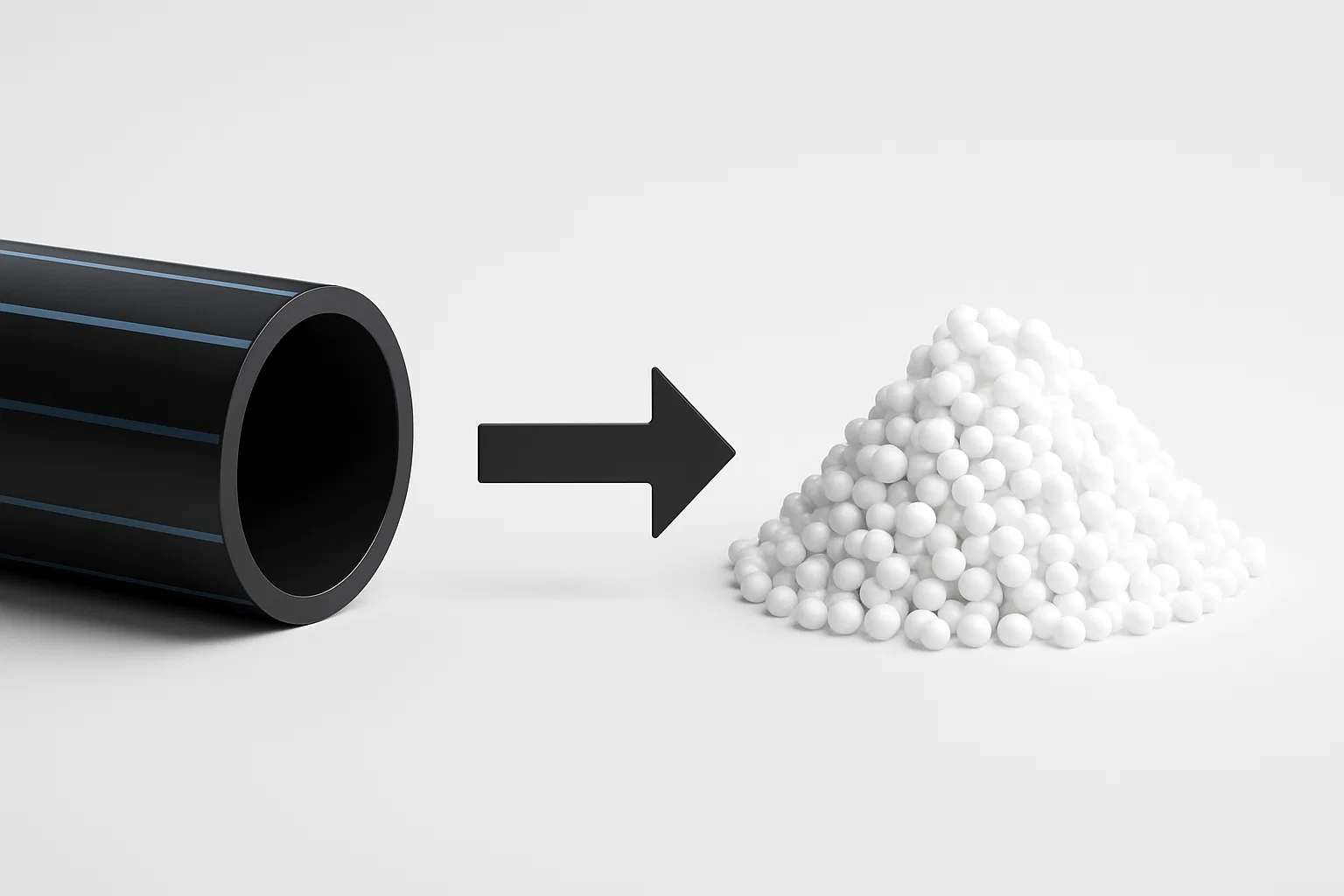En el mundo de los plásticos industriales, el polietileno de alta densidad (HDPE) destaca por su durabilidad, resistencia a la corrosión y versatilidad. Es la base de la infraestructura moderna, y se utiliza en todo, desde sistemas municipales de agua y distribución de gas hasta conductos de telecomunicaciones. Pero con la producción y el reemplazo de millones de toneladas de tuberías de HDPE, surge una pregunta crucial: ¿qué ocurre con este valioso material al final de su vida útil?
La respuesta está en un proceso de reciclaje sólido y rentable.
Para los operadores de reciclaje industrial, contratistas y gestores de residuos municipales, las tuberías de HDPE desechadas no son una carga; son un recurso valioso que espera ser aprovechado. Esta guía completa le guiará paso a paso por todo el proceso de reciclaje de tuberías de HDPE, mostrándole cómo convertir un flujo de residuos voluminoso en una fuente de ingresos de alta demanda.
Capítulo 1: El proceso de reciclaje de tuberías de HDPE: un desglose paso a paso
La transformación de una tubería de 15 metros de largo y paredes gruesas en pellets de plástico reutilizables es un proceso de varias etapas. Cada paso es crucial para garantizar la calidad y el valor de mercado del producto final.
Paso 1: Recolección y clasificación
El proceso comienza en la fuente. Las tuberías de HDPE se recogen en obras de construcción, proyectos de modernización de infraestructuras e instalaciones industriales. Durante esta fase, es importante clasificar las tuberías, separando el HDPE (plástico #2) de otros materiales como el PVC o los accesorios metálicos. Si bien es inevitable que haya cierta contaminación, una buena clasificación inicial simplifica el proceso posterior.
Paso 2: Limpieza primaria
Las tuberías recolectadas suelen estar cubiertas de suciedad, lodo u otros residuos. Un lavado preliminar elimina estos contaminantes superficiales, lo cual es vital para proteger el equipo de procesamiento del desgaste excesivo en las siguientes etapas.
Paso 3: Reducción de tamaño: la fase crítica de trituración
Esta es la etapa más difícil, y la más importante, del reciclaje de tuberías de HDPE. Debido a su gran diámetro, longitud y paredes resistentes, las tuberías de HDPE no pueden introducirse directamente en un granulador. Primero deben descomponerse en trozos más pequeños y manejables.
Aquí es donde un motor industrial de alto torque Trituradora de tubos de HDPE Se convierte en el elemento central de la operación. A diferencia de los granuladores de alta velocidad, una trituradora opera a baja velocidad con un gran par motor, lo que le permite:
- Agarrar y tirar Tuberías grandes y voluminosas sin dificultad.
- Cortar a través de paredes gruesas de forma limpia y eficiente, evitando atascos.
- Manejar la contaminación moderada como suelo residual sin daños significativos en las cuchillas.
El resultado de la trituradora son virutas de plástico gruesas de tamaño uniforme (normalmente de 40 a 100 mm), que ahora son perfectas para los pasos de procesamiento posteriores.
Paso 4: Lavado secundario y separación
Los chips de HDPE triturados se someten a un proceso de limpieza más intensivo. Normalmente se introducen en una lavadora de fricción o en un tanque de flotación-hundimiento. En este último, el HDPE, con una densidad inferior a 1 g/cm³, flota, mientras que los contaminantes más pesados, como fragmentos de metal, rocas u otros plásticos (como el PVC), se hunden. Este proceso de purificación es muy eficaz.
Paso 5: Secado
Para preparar la fundición, es necesario eliminar toda la humedad de las astillas de plástico. Las astillas limpias se pasan por un secador térmico o centrífugo hasta que su contenido de humedad es extremadamente bajo. Un secado incompleto puede comprometer la calidad de los pellets finales.
Paso 6: Fusión y peletización (extrusión)
Los chips de HDPE secos y limpios se introducen en una extrusora. Dentro de la extrusora, se calientan, se funden y se homogeneizan hasta obtener un plástico fundido consistente. Este plástico fundido se introduce a presión en una matriz, formando largas hebras con aspecto de espagueti. Estas hebras se enfrían inmediatamente en un baño de agua y se cortan en pequeños gránulos mediante una peletizadora.
Estos pellets son el producto final: una materia prima reciclada de alta calidad, lista para ser vendida y utilizada para fabricar nuevos productos.
Capítulo 2: Por qué la trituradora es su inversión más importante
Para cualquier persona que se tome en serio el reciclaje de tuberías de HDPE, la elección del equipo de reducción de tamaño es fundamental. Si bien un granulador es excelente para plásticos pequeños y frágiles, no es adecuado para el procesamiento inicial de tuberías grandes.
Invertir en una propiedad construida específicamente para ese fin trituradora diseñada para tuberías de HDPE No es un gasto, sino una inversión fundamental en eficiencia operativa. Las características clave a considerar incluyen:
- Motor de alto par y baja velocidad: Esencial para proporcionar la potencia para procesar materiales duros sin riesgo de sobrecalentamiento o bloqueos.
- Cuchillas robustas y resistentes al desgaste: El sistema de corte debe estar diseñado para soportar la naturaleza abrasiva del HDPE y los posibles contaminantes.
- Abertura de alimentación grande: La trituradora debe poder adaptarse a los grandes diámetros de las tuberías que pretende procesar.
- Sistema de control inteligente: Las trituradoras modernas cuentan con funciones de reversión automática que eliminan automáticamente posibles atascos, lo que garantiza un funcionamiento continuo y sin intervención humana.
Capítulo 3: El mercado de pellets de HDPE reciclado
La demanda de HDPE reciclado de alta calidad es fuerte y está en crecimiento, impulsada por los objetivos de sostenibilidad de las empresas y las regulaciones gubernamentales. Los pellets que usted produce pueden venderse a fabricantes para crear una amplia gama de nuevos productos, entre ellos:
- Tuberías nuevas no presurizadas (por ejemplo, para drenaje o riego agrícola)
- Madera compuesta para terrazas y muebles de exterior
- Contenedores, papeleras y palés de plástico
- Piezas de automoción
- Bolsas y películas de plástico
Conclusión: Del desafío a la oportunidad
El reciclaje de tuberías de HDPE representa una importante oportunidad ambiental y económica. Lo que comienza como un desafío logístico —la eliminación de tuberías voluminosas y usadas— puede transformarse en una línea de negocio rentable con el proceso y la tecnología adecuados.
La transformación de una tubería desechada en un valioso pellet depende de un proceso de reducción de tamaño eficiente, potente y fiable. Al comprender cada paso y reconocer la importancia de una trituradora robusta de tuberías de HDPE, su operación puede aprovechar eficazmente este mercado en crecimiento, convirtiendo los residuos industriales en riqueza industrial.
¿Listo para desarrollar su operación de reciclaje? Contacte con nuestro equipo de ingeniería para hablar sobre la solución de trituración ideal para sus necesidades específicas.



